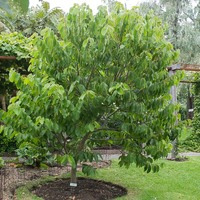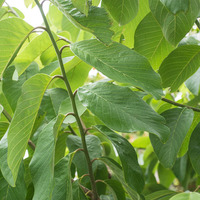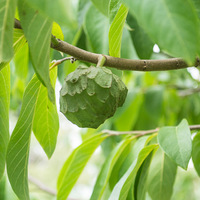Description
Cherimoya is a cool-climate relative of the custard apple originating from high-elevation areas in South America, its natural range extending along the Andes from Ecuador to Peru.
It is a small deciduous tree reaching heights of up to 10 m (32 ft), though it is more commonly 3 to 7 m (10 to 23 ft) tall, usually with a single trunk, but occasionally with multiple trunks in a V-shape. Branching starts low on the tree with the branches horizontal and wide-spreading, forming a large, rounded and densely leafy crown.
There are many different Cherimoya varieties and cultivars that are mostly distinguishable by their leaf shape, fruit shape and fruit size. The leaves are generally oval, medium green, up to 15 cm (6 in) long and alternately arranged along the ends of the branches. They fall off the tree in the dry season to conserve water, just before the new leaves start to emerge, leaving them bare and exposed for a brief period.
Cherimoya requires a cool, dry period leading up to flowering for good flowering to occur. The flowers are bisexual, tube-shaped when first formed, opening into three yellow-green petals. They are borne singly or in two's or three's along the branches, from the end of spring into summer, coinciding with new leaf growth.
The fruit are medium-sized, heart-shaped, light green and either smooth-skinned with dimples or with raised bumps, depending on the variety. Individual fruit can range in weight from 2 kg (4.4 lbs) down to 100 grams (3.5 oz) but are typically in the 300 to 600 gram (0.7 to 1.3 lb) weight range. They mature around four to six months after fruit-set, usually in autumn to early winter and retain their light-green skin colour even when ripe.
Use
The fruit is eaten fresh out-of-hand when ripe and soft to the touch, usually by tearing or slicing it in half or into pieces and scooping out the pulp, which is white, aromatic, smooth with a melting texture and an agreeable sub-acid flavour. Care is taken to avoid the glossy black, oval seed or they are spat out when eating the pulp. The seedless pulp is also added to chilled desserts, such as ice-cream.
Health use
Cherimoya fruit pulp is rich in natural sugars and is a good source of energy. It also contains high levels of Vitamins B1 (Thiamine), B2 (Riboflavin), B3 (Niacin) and Vitamin C (Ascorbic acid), as well as having a higher than average Potassium content.
Climate
Cherimoya grows, flowers and fruits reliably in humid subtropical and tropical high-elevation climates, generally areas with annual lows of 9 to 16°C, annual highs of 19 to 30°C, annual rainfall of 500 to 2000 mm and a dry season of 2 to 7 months, extending to 12 months with irrigation or groundwater.
Cherimoya trees may fail to flower and fruit, or do so poorly, in areas where the average low of the coldest month is above 13°C (55°F)
Growing
New plants are usually started from cuttings grafted onto rootstock because seed-grown trees do not always inherit the characteristics of the parent.
Good results have been had from cuttings grafted onto Cherimoya seedlings, as well as onto seedlings of other Annona species, including Bullock heart (A. reticulata), Soursop (A. muricata) and Pond apple (A. glabra). Grafted trees are reported to start bearing fruit within two to four years under good growing conditions.
It is most productive on free-draining loam, sandy-loam and loamy-sand soils of a moderately acid to slightly alkaline nature, generally with a pH of 5.0 to 7.5 and on sites with full to partial sun exposure. It is intolerant of clayey, slow-draining or waterlogged soils and seasonal flooding.
The tree benefits from a light pruning each year to stimulate new growth and the application of a high-potassium, general-use organic fertiliser in spring and summer is recommended for the production of good quality fruit.
Hand pollinating is a practised to increase fruit set and yield, which can be low due to the female and male parts of the flower maturing at different times. This helps as well to reduce the incidence of malformed fruit, another fruiting problem resulting from poor pollination. The process involves taking pollen from pollen-ripe flowers and using it to fertilise receptive flowers.
Problem features
Cherimoya is recorded as a weed in at least one reference publication and is reported to have naturalised above 1000 m (3200 ft) in Jamaica, but there does not appear to be any reports of it being a serious weed anywhere in the world. It is assessed as a low weed risk species for Hawaii by the Hawaii Pacific Weed Risk Assessment project (HPWRA).
Where it grows
References
Books
-
Adams, C. D. 1972, Flowering plants of Jamaica, University of the West Indies, Mona, Greater Kingston
-
Editors of Sunset Magazine 2012, The New Western Garden Book: The Ultimate Gardening Guide, 9th edition, Sunset Publishing Corporation, California
-
George, A. et al. 1998, Custard Apple Information Kit, your growing guide to better farming, Agrilink Series QAL9904. Queensland Department of Primary Industries (QLD DPI), Brisbane
-
Iremonger, S. 2002, A guide to plants in the Blue Mountains of Jamaica, University of the West Indies Press, Kingston, Jamaica
-
Jacobson, M. 1958, Insecticides from plants : a review of the literature, United States Department of Agriculture (USDA), Washington D.C.
-
Janick, J., & Paull, R. E. 2008, The encyclopedia of fruit & nuts, CABI Publishing, Wallingford, Oxfordshire
-
Kennard, W. C. & Winters, H. F. 1960, Some fruits and nuts for the tropics, Miscellaneous Publication No. 801, U.S. Department of Agriculture, Federal Experimental Station, Mayaguez, Puerto Rico
-
Leon, J & Hernandez Bermejo, J. Esteban & Programma Ethnobotanica 92. 1994, Neglected crops : 1492 from a different perspective, Food and Agriculture Organization of the United Nations, Rome
-
Love, K. & Bowen, R. & Fleming, K. 2008, Twelve Fruits with Potential Value Added and Culinary Uses, University of Hawaii Press, Hawaii
-
Macmillan, H. F. 1943, Tropical planting and gardening : with special reference to Ceylon, 5th ed, Macmillan Publishing, London
-
Martin, F. M., et al. 1987, Perennial edible fruits of the tropics : an inventory, U.S. Dept. of Agriculture (USDA), Agricultural Research Service, U.S. Government Printing Office (GPO), Washington, D.C.
-
Morton, J. F. & Dowling, C. F. 1987, Fruits of warm climates, Creative Resources Systems, Winterville, North Carolina
-
National Research Council (Board on Science and Technology for International Development) 1989, Lost Crops of the Incas: Little-Known Plants of the Andes with Promise for Worldwide Cultivation, The National Academies Press, Washington D. C.
-
Perkins, K. D. & Payne, W. 1981, Guide to the poisonous and irritant plants of Florida, Florida Cooperative Extension Service, Gainesville, Florida
-
Randall, R. P. 2007, The introduced flora of Australia and its weed status, Cooperative Research Centre for Australian Weed Management, Glen Osmond, South Australia
-
Standley, P. C. 1920, Trees and shrubs of Mexico, Government Printing Office (GPO), Washington D.C.
-
Van Wyk, B. E. 2005, Food plants of the world: an illustrated guide, 1st ed., Timber Press, Portland, Oregon
-
Wenkam, N.S. 1983 to 1990, Foods of Hawaii and the Pacific Basin (5 volumes), College of Tropical Agriculture and Human Resources, University of Hawaii, Honolulu
Articles, Journals, Reports and Working Papers
-
Percival, S. & Findley, B. 2007 (Reviewed April 2014), What's in Your Tropical Fruit?, Fact Sheet HN 0708, University of Florida IFAS Extension Service, Gainesville, Florida
-
Watson, B.J., & Moncur, M. 1985, Guideline criteria for determining survival, commercial and best mean minimum July temperatures for various tropical fruit in Australia (Southern Hemisphere), Department of Primary Industries Queensland (DPI QLD), Wet Tropics Regional Publication, Queensland
-
Wenkam N.S. & Miller C.D. 1965, Composition of Hawaii fruits (Bulletin 135), University of Hawaii, Honolulu




